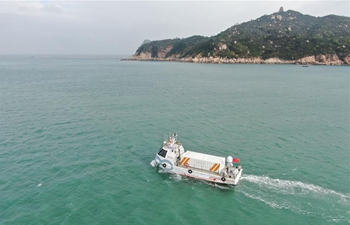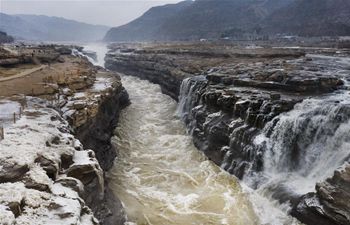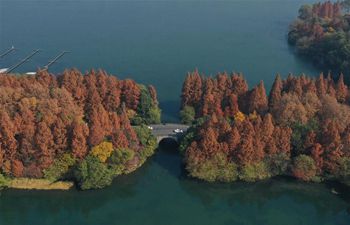TOKYO, Dec. 23 (Xinhua) -- Japanese industry ministry on Monday recommended a number of measures that could be used to discharge radioactive water building up at the disaster-stricken nuclear complex in Fukushima Prefecture.
Such measures could involve dumping the contaminated water into the Pacific Ocean, vaporizing it or a process of discharging it which combines both methods.
The proposals for discharging the radioactive water from the Daiichi nuclear facility in Japan's northeastern Fukushima Prefecture were submitted to a subcommittee within the government, as the plant, which was crippled by an earthquake-triggered tsunami more than eight years ago, is struggling to store the massive amounts of radioactive water still being generated.
In November, the industry ministry told a government subcommittee on the matter that releasing the water into the Pacific over a period of a year would lead to one-1,600th and one-40,000th of the amount of radiation that human beings are naturally exposed to annually and doing so would create a "significantly small" health risk to humans.
The disaster-hit Fukushima plant has being storing water that has been used to keep the cores, which have undergone meltdowns since the plant was hit by a massive earthquake-triggered tsunami in March 2011.
The water used to cool the melted-down cores and groundwater at the battered plant, however, is contaminated with radioactive materials.
The plant is struggling to store the contaminated water in tanks at the plant and the amount of water collected has almost reached capacity, with the levels rising on a daily basis and space rapidly running out.
But local fisherman, whose business has already been adversely affected by the 2011 nuclear disaster, with 22 countries and regions still restricting imports of Japanese agricultural and fishery products, have opposed the move to dump the water, forcing the subcommittee to look for other options.
These included discharging the water into the soil, using electrolysis to hydrogenate tritium, as well as the possibility of encasing the contaminated water and burying it underground.
The ministry now maintains that discharging the radioactive water into the ocean or the air by vaporization would be of minimal risk to humans. While a combination of vaporization and releasing the water into the ocean is also on the table as this method may limit the impact on local fisherman.
"I don't think there were objections from a technical perspective on releasing the water into the ocean, or vaporization," a ministry official was quoted as saying after Monday's meeting.
"But overall, to use the two options as a decision-making base is questionable," the official said.
Previously, however, subcommittee members have voiced their concerns over how different factors could affect the impact of the release of contaminated water into the ocean, such as the weather and the currents of the ocean.
In addition, concerns have been voiced over the actual amount of radiation that humans could be internally exposed when factoring in their consumption of contaminated fish and seaweed.
Local fishermen have expressed their vehement opposition to any contaminated water being dumped into the ocean.
They argued that such a move would adversely affect the reputation of their produce and make it difficult for them to earn a living.
Some neighboring countries have also voiced their opposition to the idea of discharging the water into the ocean or atmosphere, citing environmental concerns.













